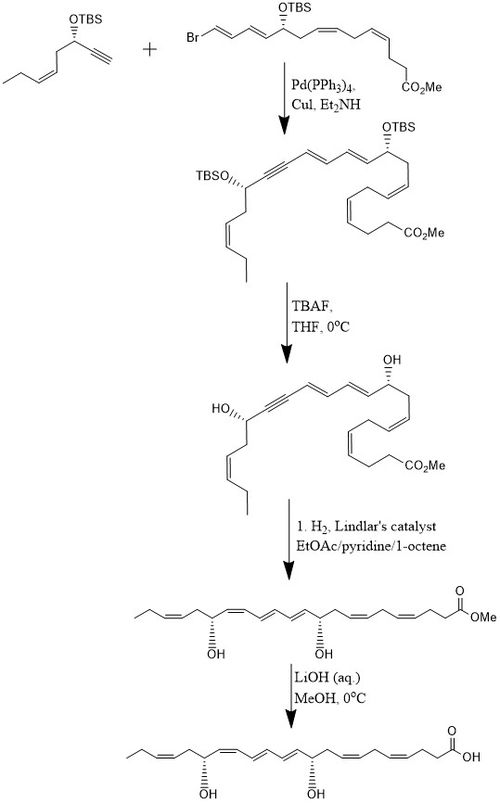Protectin D1
| Names | |
|---|---|
| Preferred IUPAC name
(4Z,7Z,10R,11E,13E,15Z,17S,19Z)-10,17-Dihydroxydocosa-4,7,11,13,15,19-hexaenoic acid | |
| Other names
10R,17S-Dihydroxy-docosa-4Z,7Z,11E,13E,15Z,19Z-hexaenoate; 10R,17S-Dihydroxy-docosa-4Z,7Z,11E,13E,15Z,19Z-hexaenoic acid; Neuroprotectin D1
| |
| Identifiers | |
3D model (
JSmol ) |
|
| ChemSpider | |
PubChem CID
|
|
| UNII | |
| |
| |
| Properties | |
| C22H32O4 | |
| Molar mass | 360.4871 g/mol |
| Density | 1.049 g/cm3 |
| Boiling point | 559.379 °C (1,038.882 °F; 832.529 K) |
| 0.0069 | |
| log P | 4.95 |
| Acidity (pKa) | 4.82 |
Except where otherwise noted, data are given for materials in their standard state (at 25 °C [77 °F], 100 kPa).
| |
Protectin D1 also known as
Specifically, PD1 is an endogenous stereoselective lipid mediator classified as an
PD1 has a significant role as an anti-inflammatory, anti-apoptotic and neuroprotective molecule. Studies in Alzheimer's disease animal models, in stroke patients and in human retina pigment epithelial cells (RPE) have shown that PD1 can potentially reduce inflammation induced by oxidative stress and inhibit the pro-apoptotic signal, thereby preventing cellular degeneration.[2][3][4][5] Finally, recent studies examining the pathogenicity of influenza viruses, including the avian flu (H5N1), have suggested that PD1 can potentially halt the proliferation of the virus, thus protecting respiratory cells from lethal viral infections.[6][7]
Biosynthesis of PD1
In vivo, PD1 is mainly produced as a response to inflammatory signals and it is found in various tissues, such as the
Functions of PD1
In general, PD1 in vivo exhibits a potent anti-apoptotic and anti-inflammatory activity in the tissues in which it is localized. DHA, the main PD1 precursor, is mostly found in tissues such as the retinal synapses, photoreceptors, the lungs and the brain, suggesting that these tissues are more likely to be benefited from the protecting activity of PD1.[1][2][3][4][7][8]
Activity of PD1 in the retina
RPE are essential in the survival and renewal of the photoreceptors in the retina. These cells exhibit a potent phagocytic activity that ensures the proper function of the retina. Therefore, oxidative stress can potentially damage the RPE cells and cause vision impairment. Studies in human RPE cells have suggested that the presence of oxidative stress triggering molecules, such as H2O2 causes the fragmentation of the DNA that in turn triggers apoptosis.[2] These studies have proposed that PD1 acts as a signaling molecule and through its ligand-receptor interaction down-regulates the expression of genes, such as the transcription factor NF-κB. The inhibition of NF-κB results in the down-regulation of the pro-inflammatory gene COX-2 (cyclooxygenase-2) which is responsible for the release of prostaglandins, a potent pro-inflammatory mediator.[2] In addition, PD1 has an important role in regulating the expression of the Bcl-2 family proteins (Bcl-2, Bcl-xL, Bax and Bad) that precedes the release of the cytochrome c complex from the mitochondria and the formation of the apoptosome.[2][3][4] The presence of PD1 up-regulates the expression of the anti-apoptotic proteins Bcl-2 and Bcl-xL, while it inhibits the expression of the pro-apoptotic proteins Bax and Bad.[2] Specifically, PD1 regulates this protein family by promoting the dephosphorylation of Bcl-xL by protein phosphatase 2A (PP2A) at residue Ser-62 which in turn heterodimerizes with the pro-apoptotic protein Bax and inactivates it.[4] Consequently, the activity of the Bcl-2 family proteins results in the inhibition of the caspase 3 enzyme, thus preventing apoptosis and promoting RPE cell survival.[2][4]
Effects of PD1 in Alzheimer's disease
Among others,
Antiviral activity of PD1
Studies in cultured human lung epithelial cells infected with the influenza virus H1N1 or H5N1 have found that endogenous production of PD1 decreases dramatically during infection due to the inhibition of 15-LO-1.[6][7] Furthermore, the same studies have shown that in vivo administration of PD1 to H1N1 infected mice can potentially inhibit both the proliferation of the virus and the inflammation caused by the infection, thus increasing survival. PD1 protects against viral infections by disrupting the virus life cycle. Specifically, PD1 inhibits the binding of viral RNA to specific nuclear export factors in the host cells, thus blocking the export of viral RNA from the nucleus to the cytosol.[6][7] The nuclear RNA export factor 1(NXF1) is of particular interest in the attenuation of viral infections via the activity of PD1. Specifically, the NXF1 transporter through its middle and C-terminal domains binds to the phenylalanine/glycine repeats in the nucleoporins (Nups) that line the nuclear pore.[7] In the absence of PD1, influenza viral RNA binds to the NXF1 transporter that later binds specifically to Nup62 nucleoporin and exports the viral RNA into the cytosol. However, the administration of PD1 has shown that this lipid mediator specifically inhibits the binding of the viral RNA to NXF1, thus disrupting the proliferation of the virus.[7]
Laboratory Synthesis of PD1
The large scale industrial production of PD1 is of great interest for pharmaceutical companies in order to harvest the potent anti-inflammatory and anti-apoptotic activities of this lipid mediator. So far, very few stereoselective laboratory syntheses of PD1 have been reported, but with a relatively low yield.[10][11]
Convergent Stereoselective Synthesis
According to one method, PD1 is synthesized in 15% yield through an 8-step
Alternative Stereoselective Synthesis
Alternatively, PD1 laboratory synthesis proceeds through a different stereoselective method.[11] Initially, hydroboration of a TBS-protected acetylene with Sia2BH produces a TBS-protected vinylborane. The TBS-protected vinylborane reacts with vinyliodide in the presence of a Pd-catalyst, sodium hydroxide (NaOH) and THF to produce a TBS-protected alcohol. Later treatment of the TBS-protected alcohol with TBAF removes the protecting group and produces a diol. Finally, the diol is hydrolyzed with LiOH in THF (aq.) to produce PD1.[11]
Other PDs
22-hydroxy-NPD1
22-hydroxy-PD1 (22-OH-PD1; i.e. 10R,17S,20-trihydroxy-4Z,7Z,11E,13E,15Z,19Z-docosahexaenoic acid) is an
Protectin DX
Protectin DX (PDX; i.e. 10S,17S-dihydroxy-4Z,7Z,11E,13Z,15E,19Z-docosahexaenoic acid) is the 13Z,15E,19Z isomer of NPD1 (which has the 13E,15Z,19Z double bond configuration)(see
Aspirin-triggered PD1
Aspirin-triggered PD1 (AT-PD1 or 17-epi-PD1: i.e. 10R,17R-dihydroxy-4Z,7Z,11E,13E,15Z,19Z-docosahexaenoic acid) is the 10R-hydroxy isomer of PD1 (which has the 10S hydroxy residue) (see
10-epi-PD1
10-Epi-PD1 (ent-AT-NPD1: i.e. 10S,17S-Dihydroxy-4Z,7Z,11E,13E,15Z,19Z-docosahexaenoic acid) is the 10S-hydroxy isomer of AT-PD1 (which has a 10R-hydroxy residue) (see



